* You are viewing Posts Tagged ‘Illustration’
James Brown
September 24, 2012
Events, Exhibitions, Lectures, Project Updates
Tags: Animals, Book History, Conchology, Gender, History of Science, Illustration, Martin Lister, Natural History, Seventeenth Century, Women
Post updated to include photographs
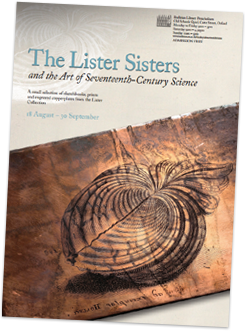 Our Martin Lister Research Fellow Anna Marie Roos has curated a small exhibition entitled ‘The Lister Sisters and the Art of Seventeenth-Century Science’, which will run in the Proscholium of the Old Bodleian Library from 18 August to 30 September (the poster can be downloaded here [pdf]). The free display showcases a unique set of drawings, prints, and copperplates of molluscs and their shells, (re)discovered among the library’s holdings by Anna Marie in 2010, which formed the basis for the illustrations in Martin Lister’s conchological magnum opus, the Historiae Conchyliorum (1685-92). Prepared by Lister’s teenage daughters, Susanna and Anna, the materials shed light on representational conventions within late seventeenth-century natural history, as well as on the gendered nature of illustrative practice in this boom era for lavishly illuminated scientific books. Anna Marie will also be giving a free lecture on ‘The Art of Science: The Rediscovery of the Lister Copperplates’ at 1pm on Wednesday 19 September in the Bodleian’s Convocation House (more info and booking on the library website). Further details of both events on The Conveyor.
Our Martin Lister Research Fellow Anna Marie Roos has curated a small exhibition entitled ‘The Lister Sisters and the Art of Seventeenth-Century Science’, which will run in the Proscholium of the Old Bodleian Library from 18 August to 30 September (the poster can be downloaded here [pdf]). The free display showcases a unique set of drawings, prints, and copperplates of molluscs and their shells, (re)discovered among the library’s holdings by Anna Marie in 2010, which formed the basis for the illustrations in Martin Lister’s conchological magnum opus, the Historiae Conchyliorum (1685-92). Prepared by Lister’s teenage daughters, Susanna and Anna, the materials shed light on representational conventions within late seventeenth-century natural history, as well as on the gendered nature of illustrative practice in this boom era for lavishly illuminated scientific books. Anna Marie will also be giving a free lecture on ‘The Art of Science: The Rediscovery of the Lister Copperplates’ at 1pm on Wednesday 19 September in the Bodleian’s Convocation House (more info and booking on the library website). Further details of both events on The Conveyor.
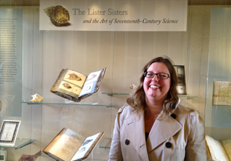
Anna Marie in front of the display

Lecturing in Convocation House
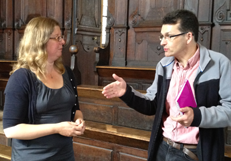
In conversation with Stephen Johnston

The exhibition proves a hit
Applications are invited for TWO AHRC Collaborative PhD studentships, commencing in autumn 2012, on the theme of Reconnecting Sloane: Texts, Images, Objects:
- Collecting and Correspondence: Sloane’s Papers and Scientific Networks (Supervised by Dr Arnold Hunt, British Library and Dr Anne Goldgar, King’s College London)
- Putting Nature in a Box: Sloane’s Vegetable Substances (Supervised by Dr Charlie Jarvis, Natural History Museum, and Professor Miles Ogborn, Queen Mary University of London)
- A third Doctoral studentship in the programme, Visualizing Natural Knowledge: Sloane’s Albums of Natural History Drawings (Supervised by Dr Kim Sloan, British Museum, and Dr Elizabeth Eger, King’s College London) has already been allocated to a named student.
Further particulars are available here (doc). Applicants can apply for both studentships, but must complete separate applications for each as outlined below.
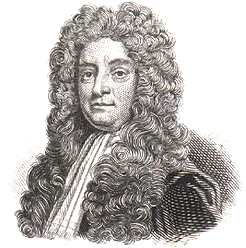 These studentships will focus on the collections of Sir Hans Sloane (1660-1753), which are now divided between the British Museum, the Natural History Museum and the British Library. The research projects will explore various aspects of Sloane’s collections in order to understand how his collecting practices were involved in the making of Enlightenment knowledge. The successful applicants will be expected to work closely with the partner institutions, and each other, in order to draw out the intellectual and material connections between the different parts of Sloane’s collections. They will also participate in the development of new finding-aids for the collections, leading to innovative forms of public engagement.
These studentships will focus on the collections of Sir Hans Sloane (1660-1753), which are now divided between the British Museum, the Natural History Museum and the British Library. The research projects will explore various aspects of Sloane’s collections in order to understand how his collecting practices were involved in the making of Enlightenment knowledge. The successful applicants will be expected to work closely with the partner institutions, and each other, in order to draw out the intellectual and material connections between the different parts of Sloane’s collections. They will also participate in the development of new finding-aids for the collections, leading to innovative forms of public engagement.
The award pays fees and an annual maintenance grant (currently £15,590 per year) and the partner institution will contribute up to £1000 pa research costs. The usual AHRC eligibility rules (pdf) apply to these studentships, including having an appropriate master’s degree by October 2012 and AHRC’s residential requirements.
For both studentships the closing date is 29 June 2012. Interviews will be held in London on 19 July 2012. Applicants will need to include a CV, two references, an academic transcript, and a 1000-word statement of purpose.
James Brown
May 25, 2012
Events, Lectures, Podcasts, Project Updates
Tags: Animals, Conrad Gessner, Felix Platter, History of Science, Illustration, Natural History, Networks, Sixteenth Century
 Podcast available on the seminar page!
Podcast available on the seminar page!
 The zoological theme continued on Thursday 3 May when Florike Egmond from Leiden University (formerly of the Clusius Project) gave a talk in our seminar series entitled The Webs of Clusius and Gessner: Correspondence, Images, and Collecting in Sixteenth-Century Natural History. In a detailed and lavishly illustrated discussion, Florike described her recent discovery of two albums of original watercolour drawings created for the sixteenth-century Swiss naturalist Conrad Gessner (1551-1558) within the Special Collections of the University of Amsterdam.
The zoological theme continued on Thursday 3 May when Florike Egmond from Leiden University (formerly of the Clusius Project) gave a talk in our seminar series entitled The Webs of Clusius and Gessner: Correspondence, Images, and Collecting in Sixteenth-Century Natural History. In a detailed and lavishly illustrated discussion, Florike described her recent discovery of two albums of original watercolour drawings created for the sixteenth-century Swiss naturalist Conrad Gessner (1551-1558) within the Special Collections of the University of Amsterdam.
Crafted in Basel by the anatomist and natural historian (and Gessner’s friend) Felix Platter (1536-1614), the images – of a menagerie of marine life, mammals, reptiles, and amphibians, across 369 pages – formed the basis of many of the illustrations within Gessner’s zoological masterwork, the Historiae Animalium (1551-1558). You can find out more about this exciting discovery in Florike’s recent blog post for the Picturing Science network, and in her recent article for the Journal of the History of Collections.
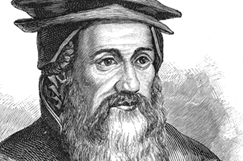
Conrad Gessner.
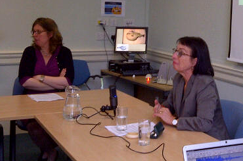
Anna Marie chairs Florike.
Renaissance correspondence networks, argued Florike, played a key role in sharing and disseminating (although not, curiously, in facilitating discussion of) manuscript images, as both Gessner, Clusius, and other naturalists solicited hand-drawn illustrations of animals to serve as the basis of woodcuts in their publications from colleagues and agents around the world. These exchanges, in turn, formed the basis of what Florike termed (with caveats) a kind of visual ‘canon formation’ within natural history, as elements of various portrayals were adapted, reworked, and reappropriated across different contexts and between media; as representational norms stabilized; and as the repertoire of animals deemed suitable for inclusion in zoological texts (whose wide remit originally encompassed familiar creatures such as cats and goats) was narrowed and standardized. A lively question and answer session focused on the artisanal communities responsible for producing the illustrations; how the works were commissioned and stored; and the frustrating but typical absence of any kind of discussion of manuscript images in the letters with which they circulated (resulting, suggested Florike, from the self-evident nature of enclosed materials).
Seminars take place in the Faculty of History on George Street on Thursdays at 3pm. For future talks in the series – and to listen to the podcast of Florike’s paper – please see the seminar webpage. All are welcome!
James Brown
May 14, 2012
Conferences and Workshops, Events, Exhibitions, Podcasts, Project Updates
Tags: Animals, Conchology, Frogs, History of Medicine, History of Science, Illustration, Insects, Martin Lister, Natural History, Ornithology, Royal Society, Seventeenth Century, Toads
Generously sponsored by the project, The Royal Society, The Wellcome Trust, the John Fell Fund, and the BSHS, sixty-three delegates attended the day-long event, which featured papers from eleven international authorities on early modern science. Speakers discussed everything from the views of French naturalists about the differences between dromedaries and camels, to the chequered history of the publication of the cabinet of natural curiosities of Albertus Seba, to the ornithology of Francis Willughby and John Ray and the scientific representation of frogs and toads.

Helen Watt, our Lhwyd researcher.

Perusing the exhibition.

Anna Marie talks to Jill Lewis.

Early modern ornithologies.
There was a concomitant exhibition in the Royal Society’s Marble Hall, also curated by Anna Marie, featuring a display of relevant books from the Society’s collections; highlights were a bear paw clam displayed alongside its illustration by Lister’s daughters in his Historiae Conchyliorum (1692-97), and John Ray’s Historia Plantarum, in which Ray deployed the terms ‘petal’ and ‘pollen’ for the first time. In a further exciting output, Anna Marie will guest edit a special conference issue of Notes and Records of the Royal Society (December 2012) dedicated to the complex interplay between seventeenth-century medicine and natural history. Dovetailing out from Lister’s own contributions, the special issue will consider to what extent practices and technologies of natural history changed between the Renaissance and the seventeenth century, and will explore how the acquisition of knowledge concerning the natural world and new taxonomies affected the perception and treatment of beasts for medical and experimental use.
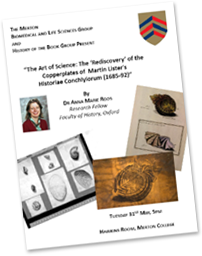 Post edited to add photographs
Post edited to add photographs
A lecture by our Martin Lister Research Fellow Dr Anna Marie Roos on ‘The Art of Science: The ‘Rediscovery’ of Martin Lister’s Historiae Conchyliorum (1685-92)’ will take place at 5pm on Tuesday 31 May in the Hawkins Room of Merton College. The event is a joint meeting of the Merton Biomedical and Life Sciences and History of the Book research groups. Anna Marie is a leading authority on the history of science and medicine in early modern England. Alongside her work for Cultures of Knowledge (for which she is editing Lister’s correspondence), she has published widely in the history of chemistry, as well as on magic and astrological medicine. Her talk will focus on the stunning series of copperplates created by Lister’s teenage daughters to illustrate his groundbreaking compendium of shells, the rediscovery of which last year aroused a great deal of interest.
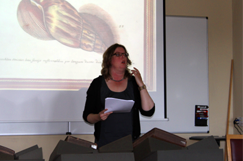
Anna Marie during her talk.
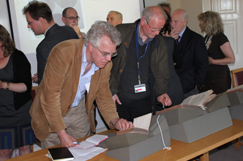
Listerian material from Merton’s holdings.

Bodleian Library, Lister Copperplates 858 (plate 787), Conus Marmoreus

When it came time to publish Historiae Conchyliorum, Lister also called upon the scientific and artistic expertise of his two daughters, Susanna and Anna Lister, who were the primary draftswomen for the copperplates and who may well have been the first women to use a microscope to assist them with their scientific illustrations.
Susanna and Anna’s copperplate etchings and other scientific drawings are currently being featured in an article and slideshow on the news page of the journal Nature, and the women’s role in early science is one of the topics discussed in Roos’s forthcoming biography of Lister, Spiderman: Martin Lister (1639-1712), Naturalist and Physician.
A collection-level description of Martin Lister’s manuscripts in the Bodleian, as well as a description of Martin Lister’s books now held by the Bodleian, are available on the library’s website. The copperplates are kept in preservation envelopes and individual plates can be located using a handlist available from the Bodleian Rare Books Section (rare.books(at)bodleian.ox.ac.uk).
 Our Martin Lister Research Fellow Anna Marie Roos has curated a small exhibition entitled ‘The Lister Sisters and the Art of Seventeenth-Century Science’, which will run in the Proscholium of the Old Bodleian Library from 18 August to 30 September (the poster can be downloaded here [pdf]). The free display showcases a unique set of drawings, prints, and copperplates of molluscs and their shells, (re)discovered among the library’s holdings by Anna Marie in 2010, which formed the basis for the illustrations in Martin Lister’s conchological magnum opus, the Historiae Conchyliorum (1685-92). Prepared by Lister’s teenage daughters, Susanna and Anna, the materials shed light on representational conventions within late seventeenth-century natural history, as well as on the gendered nature of illustrative practice in this boom era for lavishly illuminated scientific books. Anna Marie will also be giving a free lecture on ‘The Art of Science: The Rediscovery of the Lister Copperplates’ at 1pm on Wednesday 19 September in the Bodleian’s Convocation House (more info and booking on the library website). Further details of both events on The Conveyor.
Our Martin Lister Research Fellow Anna Marie Roos has curated a small exhibition entitled ‘The Lister Sisters and the Art of Seventeenth-Century Science’, which will run in the Proscholium of the Old Bodleian Library from 18 August to 30 September (the poster can be downloaded here [pdf]). The free display showcases a unique set of drawings, prints, and copperplates of molluscs and their shells, (re)discovered among the library’s holdings by Anna Marie in 2010, which formed the basis for the illustrations in Martin Lister’s conchological magnum opus, the Historiae Conchyliorum (1685-92). Prepared by Lister’s teenage daughters, Susanna and Anna, the materials shed light on representational conventions within late seventeenth-century natural history, as well as on the gendered nature of illustrative practice in this boom era for lavishly illuminated scientific books. Anna Marie will also be giving a free lecture on ‘The Art of Science: The Rediscovery of the Lister Copperplates’ at 1pm on Wednesday 19 September in the Bodleian’s Convocation House (more info and booking on the library website). Further details of both events on The Conveyor.




 These studentships will focus on the collections of Sir Hans Sloane (1660-1753), which are now divided between the British Museum, the Natural History Museum and the British Library. The research projects will explore various aspects of Sloane’s collections in order to understand how his collecting practices were involved in the making of Enlightenment knowledge. The successful applicants will be expected to work closely with the partner institutions, and each other, in order to draw out the intellectual and material connections between the different parts of Sloane’s collections. They will also participate in the development of new finding-aids for the collections, leading to innovative forms of public engagement.
These studentships will focus on the collections of Sir Hans Sloane (1660-1753), which are now divided between the British Museum, the Natural History Museum and the British Library. The research projects will explore various aspects of Sloane’s collections in order to understand how his collecting practices were involved in the making of Enlightenment knowledge. The successful applicants will be expected to work closely with the partner institutions, and each other, in order to draw out the intellectual and material connections between the different parts of Sloane’s collections. They will also participate in the development of new finding-aids for the collections, leading to innovative forms of public engagement. The
The 

 In commemoration of the 300th anniversary of the death of
In commemoration of the 300th anniversary of the death of 









 Join
Join 